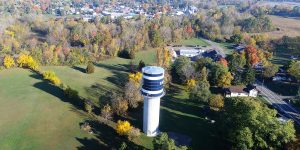
The following text is written by LaDonna Heath from Historic Glimpses of Logan County, Ohio.
Logan County Historical Society/MT Publishing, 2003.
The land that John Boggs purchased in 1805 was by 1826 a desirable location for his son William. He came with his wife and child, and was accompanied by an old friend of his father who had received land from John Boggs. These men built cabins on their acquired land. Young William built a sawmill below his cabin in 1833 and by 1840 a gristmill.
In 1850, a civil engineer named Col. Andrew DeGraff came to the area when surveying for a new railroad line to connect the Boggs area to Bellefontaine. The railway was called the Bellefontaine Line (Bee Line). Mr. DeGraff and William Boggs would work together to map out and survey the town to be named for the engineer.
Purchasing some land, John Koke and Samuel Gilfillen “platted some sixty lots, one third of which were on the southeast side of the track, but Mr. Koke could not carry out his contract and it reverted back to the original owner.”
“Three years later (1853), thirty-three lots were added between Miami and Hayes streets, and in 1856 nineteen lots between Miami and Race streets were platted. In 1858, fifty-one lots were added north of Miami street, extending into Pleasant Township.”
The “Bee Line” railroad was fully operational by the early 1860s. The town was assured success even though there were many new hurdles to cross. The opportunities for the early town outweighed the negative qualities. Quincy was having some problems during this time, and DeGraff with the free investment of Boggs’ money benefited in growth.
In 1864, the village was incorporated, with A. J. Lippincott as mayor and Mathias Wolf, recorder. Aaron Mitchell (“Old Uncle Ben”) began to purchase wheat with the aid of Mr. Boggs, and DeGraff soon was one of the best markets for grain in the county.
In 1874, improved sidewalks were made to the streets. In 1877, one half of lot #20 on Main Street was bought at a cost of $500 to erect a town hall. A fine, two story brick was erected at a cost of $3,300. A hook & ladder fire truck had been purchased in 1873 at a cost of $225. DeGraff had electricity by 1893 to light the town. In 1898, the Inland Telephone Company built an exchange.
A little-know neighborhood community was located across the Bokengehalas Creek on South Main, DeGraff. Its name was Thatcherville, named because several members of the Thatcher family built their homes in this location. The Thatcher Lumber Company stood just across the creek on the west side of the road.
The town experienced serious damage, along with neighboring Quincy, when a tornado of June 8, 1872, roared through both villages, leveling nearly everything in its path. In Quincy, about 70 buildings were all or partially destroyed and one woman (Mrs. Rose Glick) later died. DeGraff lost two children (Lulu & Callie Rall) and most of the town had businesses destroyed, many beyond repair. Both towns also suffered through the 1913 Flood.
It has been very unique that two towns in one township have continued to survive when only three miles apart. During the 1800-1900s, each town has had as many as three churches. Businesses included a post office, hotels, groceries, livery stables, banks, wagon makers, blacksmiths, drug stores, newspapers, dry goods, hardwares, restaurants, and other small shops.
DeGraff had two well-known industries (Mid-States Container and DeGraff Packing companies) through the 1900s and Quincy still in 2003 has Quincy Castings. But as people are no longer dependent on the small town businesses, we see constant changes happening in these two communities.
To help secure their identity, Quincy and DeGraff have consolidated two important facilities. The first change in 1960 brought the two rival school systems together into one new district called Riverside Local Schools located west of DeGraff. The second began in 1974 when the towns secured land for a sewage treatment plant located just north of Quincy.
